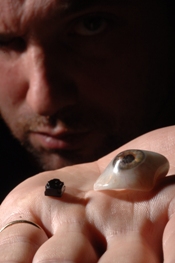 Have you ever wished that you could video what ever you see without lugging around a video camera?
Have you ever wished that you could video what ever you see without lugging around a video camera?
Rob Spence, a one eyed film maker, has found a way to do just that. Taking his cue from the 1970s television series The Six Million Dollar Man, Rob has had a camera inserted into prosthetic eye to create The EyeBorg Project.
Take a one eyed film maker, an unemployed engineer, and a vision for something that’s never been done before and you have yourself the EyeBorg Project. Rob Spence and Kosta Grammatis are trying to make history by embedding a video camera and a transmitter in a prosthetic eye. That eye is going in Robs eye socket, and will record the world from a perspective that’s never been seen before.
The possibilities for this kind of documentary making are endless. Imagine how much more at ease people would be talking one on one with someone rather than having a visible camera shoved in their face.
I’d love to do something like this but I’m not really prepared to lose an eye to do so. Of course, the way technology is going, it probably won’t be too long before we can take a direct feed from our own eyes.
The thing I’d really like is to be able to have a zoom function on my eyes like The Six Million Dollar Man had. That sure would beat having to take binoculars to the footy or concerts.
The Eyeborg Project is the work of Rob Spence, a 36 year old filmmaker residing in Toronto, Canada and Kosta Grammatis—an unemployed engineer from San Francisco, CA. The eye in question was badly damaged in an accident involving a shotgun when Rob was 13. Rob had his eye surgically removed and replaced with a prosthetic one after enduring ten years of pain. Now, with the help of Kosta and a team of ocularists, inventors, engineering specialists, Rob is building a prosthesis that can capture and transmit video. He will soon be filming the world from an entirely new perspective.
Kosta Grammatis has led the charge to solve the engineering problems involved with the endeavor. In order for the project to be successful the smallest, lightest, power efficient technologies had to be found and implemented. The world’s smallest CMOS cameras—1.5mm square are being used, small enough to be lost in a sneeze. The video signal is being transmitted wirelessly to be recorded elsewhere by an RF Transmitter that’s smaller than the tip of a pencil eraser, and lithium polymer battery technology is powering the eye. Kosta envisions that the data will be sent to a backpack to be recorded.
You can follow the project at the EyeBorg Project Blog.
Do you think some of your friends would enjoy reading The EyeBorg Project? Please use the buttons below to share the post. Thanks.

WOW! That is pretty crazy. I can’t wait to see what he sees.